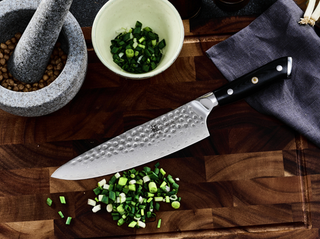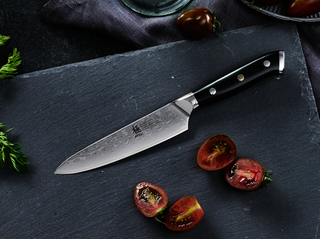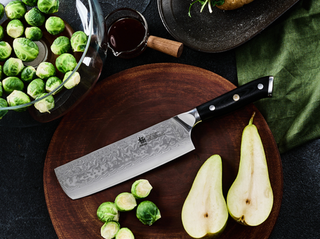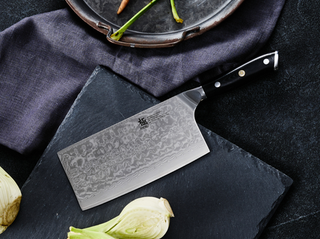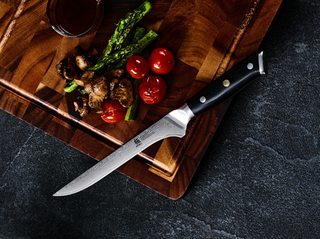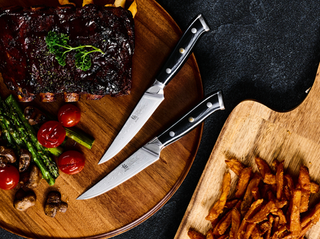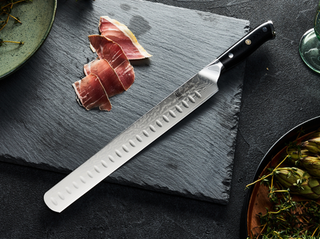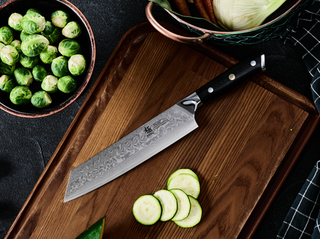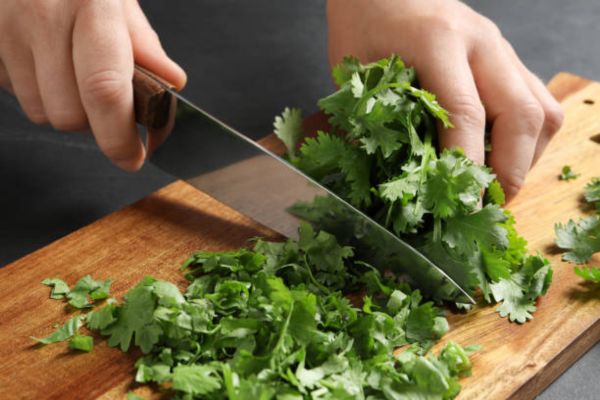Parsley is one of the most versatile herbs in the kitchen. Whether you're using it to garnish, add freshness, or boost nutrition (it’s a great source of iron), properly cut parsley makes a huge difference in both flavor and presentation.
The challenge? Many home cooks end up with bruised, mushy parsley that releases green juices and turns into a paste. The secret to avoiding that is all in the technique and the knife.
Here’s how to wash, prep, and cut parsley the right way, step by step.
 How to Cut Parsley
How to Cut Parsley
The key to cutting parsley is to wash properly, separate the parsley stalks, chop off the stems, start by chopping, and then mince to the desired texture on the chopping board. Follow these steps:
1. Wash the parsley thoroughly: Hold the parsley under cool running water. This removes dirt, soil, insects, and any debris trapped in the leaves. Clean parsley is easier to handle and cuts better.
2. Shake and dry the parsley: Moisture is the enemy of clean herb cutting. After washing, gently shake off excess water. Pat the parsley dry with a clean kitchen towel or rag. Dry parsley cuts sharply instead of smearing.
3. Separate the Parsley Stems: Each sprig of parsley has one long main stem and two shorter side stems. Split each sprig right down the middle so that the two shorter stems remain together and the longer stem is separate.
4. Line the stems in your hand: As you split the stems, line them up in the palm of your left hand, held between your thumb and index finger. This makes it easy to:
- Keep the stems organized
- Remove leaves in a consistent motion
- Speed up prep work
5. Remove the leaves from the stems: Pinch and slide the leaves off cleanly. Why remove stems? The stems are too tough for garnishing. They add an undesirable texture to delicate dishes. BUT you can freeze them for homemade stock later (they’re flavorful!)
6. Place the leaves on a cutting board: Spread the clean leaves in a loose pile on your cutting surface. Use a plastic cutting board: parsley releases green juice that can stain wooden boards.
7. Chop the parsley: This is the key step to avoid mushy parsley:
- Hold your knife with your dominant hand
- Use your other hand in a knuckle-guard position (tucking fingertips back)
- Begin with clean up-and-down chopping motions
Then switch to a gentle rocking motion to mince the parsley to your desired fineness.
Important. Use a sharp kitchen knife. A dull knife crushes the leaves and releases liquid, making them mushy and dark.
8. Gather and Mince Again (If Needed): Use the spine of your knife (never the blade edge) to gather the parsley into a pile. Continue mincing until you achieve the desired texture: fine, medium, or coarse. Stop as soon as it looks right; over-mincing causes bruising.
 Tips for Cutting Parsley Without Turning It Mushy
Tips for Cutting Parsley Without Turning It Mushy
- Always use a sharp knife. Clean slices prevent bruising and keep herbs fluffy.
- Dry the leaves completely. Wet leaves smear and stick to the knife.
- Use light pressure. Crushing parsley releases chlorophyll (green liquid).
- Work quickly. The less time the herbs spend under the knife, the better they look.
Chopping Parsley: Why Your Knife Matters
When it comes to cutting parsley, the knife you use matters for three reasons: precision, efficiency, and cleaner cuts.
A sharp, well-made knife allows you to chop parsley thinly and evenly, in a way that best preserves its texture, avoids bruising it, and helps it release flavor and aroma rather than being crushed.
With a good, sharp kitchen knife with a firm and comfortable handle, the blade does most of the work: chopping is faster and less tiring on your hands.
It is also easier to get clean, even cuts if your knife is good. Evenly cut parsley integrates smoothly into dishes and ensures consistent flavor and presentation.

Best Knives for Chopping Parsley
For chopping parsley, the best kitchen knife options are: a chef’s knife (8-inch preferably), a Nakiri Vegetable knife, and a utility knife. Consider the following blades from Kyoku for chopping parsley and any other similar herbs.
1. 8" Gyuto Chef Knife
Made of VG10 Damascus Steel, this 8-inch Gyuto Chef knife from Kyoku’s Shogun Series is a top-rated, versatile, all-purpose knife. The extra-wide and slightly curved blade provides great balance and sharpness, and the triple-riveted G10 handle makes it easy to hold and use.
Overall, it is excellent for chopping herbs, veggies, or deglazing meats.
2. 8" Chef Knife With Rosewood Handle
This 8-inch Chef knife from Kyoku’s Kage Series features a premium Japanese steel with a signature texture that adds grip, grit, and eye-catching appeal. Its sharpness and edge retention make it ideal if you chop herbs (or vegetables) frequently and want long-lasting performance.
2. Kyoku’s 7" Nakiri Knife
Also made of VG-10 Damascus Steel, this 7-inch Nakiri knife has a premium Japanese-style 67-layered blade. The flat-edge Nakiri style excels at straight-down chopping, ideal for herbs and vegetables without rocking motion. Great if you prefer push-cutting.
Explore Utility knives from Kyoku’s collection for a personalized fit and style, and perhaps find a model that matches the warmth and aesthetics of your kitchen and home.
Can You Freeze Parsley?
Yes, it is totally possible to freeze parsley. In fact, parsley freezes surprisingly well, and it’s one of the easiest herbs to preserve long-term. While the texture changes slightly after freezing (the leaves become softer), the flavor stays bright, and frozen parsley still works beautifully in:
- soups
- sauces
- stews
- marinades
- cooked dishes where fresh texture isn’t essential
Freezing parsley is also a great way to avoid waste when you buy a large bunch, but you only need a small amount.

How to Freeze Parsley (Step-by-Step)
There are two reliable ways to freeze parsley: whole leaves or pre-chopped. Both methods keep the flavor fresh for months.
Method 1: Freeze Whole Parsley Leaves
- Wash and dry the parsley thoroughly (moisture causes ice crystals).
- Strip the leaves from the stems.
- Spread the leaves on a baking sheet in a loose, even layer.
- Freeze for 1–2 hours until the leaves are firm.
- Transfer the frozen leaves to an airtight container or freezer bag.
This method keeps the leaves separate so you can easily grab a pinch at a time.
Method 2: Freeze Chopped Parsley in Ice Cube Trays
This is the best method if you cook with parsley often.
- Wash, dry, and finely chop the parsley.
- Pack the chopped parsley into an ice cube tray, about ¾ full.
- Drizzle in olive oil or water until the herbs are just covered.
- Freeze fully (usually overnight).
- Pop out the cubes and store them in a freezer bag.
These cubes are ready to toss into hot dishes: no thawing needed.
Final Thoughts on Chopping and Storing Parsley
Cutting parsley the right way makes a big difference in how fresh, flavorful, and vibrant it turns out in your dishes. With the proper prep, a sharp knife, and a simple chopping technique, you can avoid bruising the leaves and get clean, even cuts every time.
Whether you're garnishing a meal or adding herbs to a recipe, a little care in how you handle parsley goes a long way toward better texture, color, and taste.
You might be interested in our blog on how to cut celery for multiple dishes.
